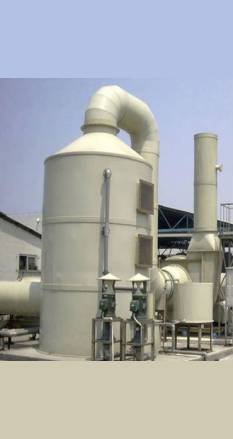Fume Scrubber System
A fume scrubber system is a device used to remove pollutants and harmful gases from industrial exhaust streams. The system works by spraying a liquid or chemical solution into the exhaust stream to absorb or neutralize the pollutants. The treated exhaust gas is then released into the environment, while the removed pollutants are typically collected and disposed of properly. Fume scrubber systems are commonly used in industries such as chemical manufacturing, pharmaceuticals, and metal processing to reduce the harmful effects of air pollution.
What Is Fume Scrubber System ?
A fume scrubber system is a type of air pollution control equipment that is used to remove harmful gases and pollutants from industrial exhaust streams before they are released into the environment. The system works by spraying a liquid or chemical solution into the exhaust stream, which then reacts with or absorbs the pollutants, effectively cleaning the exhaust gas.
Fume scrubber systems are commonly used in a variety of industrial applications, such as chemical manufacturing, pharmaceutical production, and metal processing, to reduce the impact of harmful air pollutants on the environment and the health of workers and surrounding communities.
Fume scrubber systems can be customized to meet the specific needs of different industries and applications, and they may include various features such as multiple stages of scrubbing, recirculation of scrubbing liquid, automatic pH control, and monitoring sensors to ensure optimal system performance and safety.
Fume Scrubber System Features & Benefits
Features of a fume scrubber system may include:
1. Various materials of construction - such as fiberglass, plastic, or stainless steel to accommodate corrosive environments.
2. Multiple stages of scrubbing - for removing a wide range of pollutants and controlling emissions more effectively.
3. Recirculation of scrubbing liquid - to conserve water, energy and reduce operating costs.
4. Automatic pH control - to maintain the optimal chemical conditions for effective pollutant removal.
5. Monitoring sensors - to provide real-time data on system performance, and safety shutdowns in the event of system failure.
Benefits of a fume scrubber system may include:
1. Compliance with environmental regulations - by removing pollutants and reducing emissions.
2. Improved air quality - for a healthier workplace and surrounding community.
3. Protection of equipment - by preventing corrosion and reducing maintenance costs.
4. Reduced operating costs - through recirculation of scrubbing liquid and energy recovery systems.
5. Customizable designs - to fit the specific needs and requirements of different industries and applications.
Advantages
Highly rigid
Low maintenance cost
Easy to install
High performance
No risk of harmful gases exhaust
Environment friendly
Fume Scrubber Application
Fume scrubber systems are used in a variety of industrial applications where harmful gases and pollutants are generated during production processes. Some common applications of fume scrubber systems include:
1. Chemical manufacturing - to remove acidic or corrosive gases, such as hydrochloric acid, sulfuric acid, or ammonia.
2. Pharmaceutical production - to control emissions of volatile organic compounds (VOCs) and hazardous air pollutants (HAPs) from solvent-based processes.
3. Metal processing - to remove particulate matter and other pollutants, such as heavy metals and acids, from exhaust streams.
4. Semiconductor manufacturing - to control emissions of toxic and corrosive gases, such as hydrofluoric acid, nitrogen oxides, and sulfur dioxide
5. Power generation - to reduce the emission of sulfur dioxide and nitrogen oxides from flue gases produced by burning coal or oil.
6. Waste incineration - to remove pollutants and reduce emissions of hazardous air pollutants, such as dioxins and furans.
Overall, fume scrubber systems are used in a wide range of industries and applications to reduce the environmental impact of industrial processes and protect workers and the surrounding community from harmful air pollutants.

